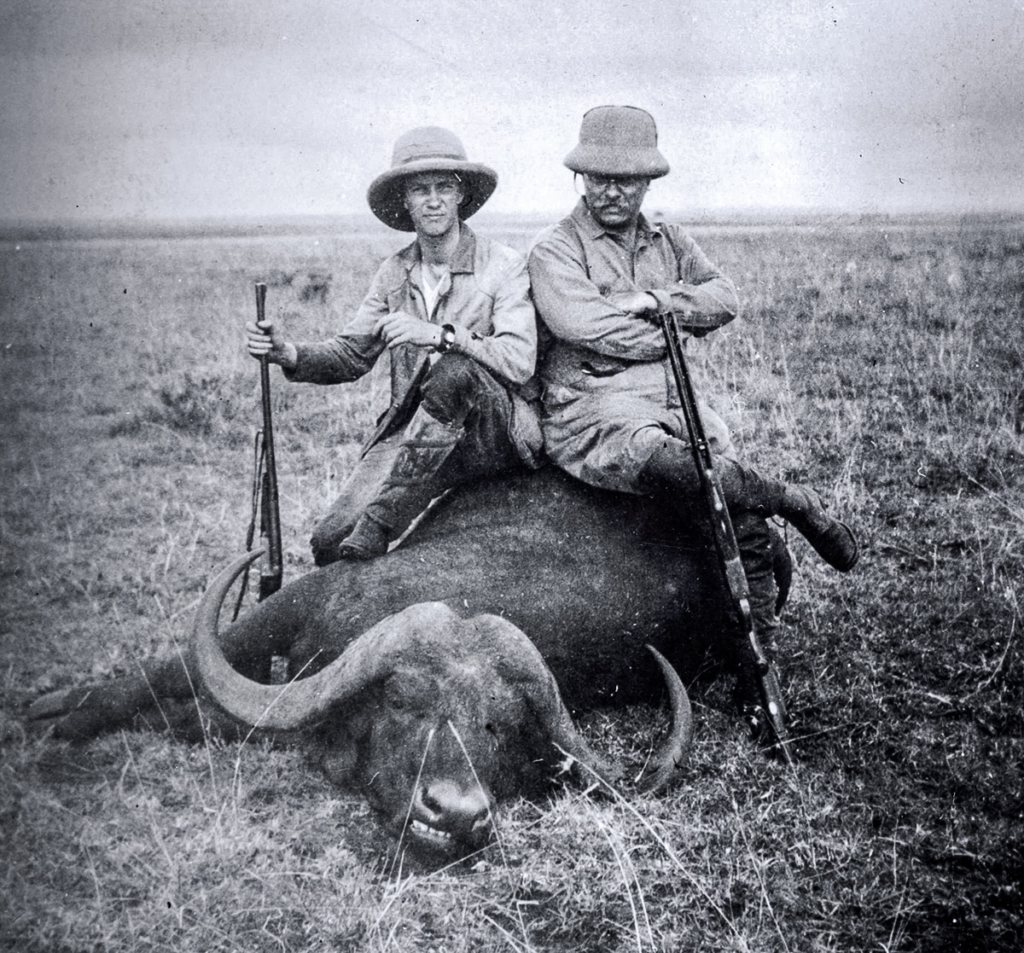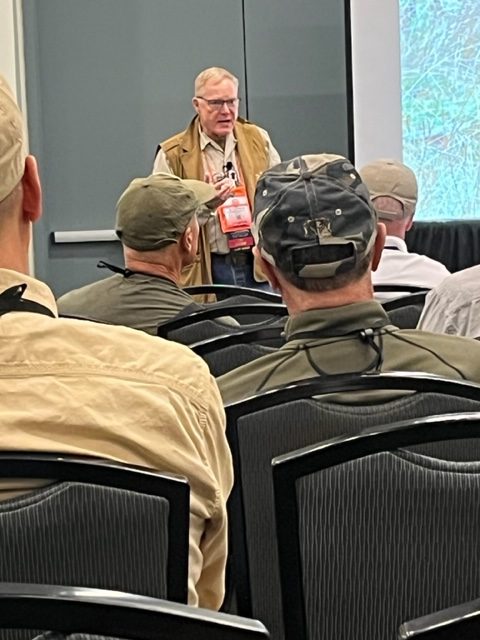The Complementary Spouse and I arrived in Nashville for the Safari Club International Convention at noon on the first day of the event. That put us there in time to catch Craig Boddington’s seminar on Hunting African Buffalo.

The seminar was very comprehensive and covered all six species of African buffalo, where they are found, their differences, how to hunt them, how to judge a trophy, hunting in various countries, and meat utilization. Few hunters have the breadth or depth of hunting buffalo over such a long period of time as Craig Boddington.
Look at the picture above of Teddy Roosevelt and his son Kermit on their famous 1909 safari in which they took 512 animals. To an uneducated eye, that looks like a good Cape buffalo and for 1909 it probably was. For today, not so great. Today it would be considered an immature bull as its boss or helmet-like covering of its horns had not hardened. However, in 1909, the rinderpest virus had wiped out much of the Cape Buffalo herd across Africa along with much of the domestic cattle. Cape buffalo were few and far between making Roosevelt’s probably as good as it got.

Buffalo are found from sub-Sahara Africa all the way to the tip of South Africa. They tend to be smaller as you go from east to west in central Africa as well as lighter in color. The Southern Cape buffalo is both the largest and most numerous of the buffalo.
According to Craig, there are six sub-species of buffalo. These include:
- Southern Cape – Found in southern and east Africa
- Nile – Found in Uganda and Sudan
- Central African Savannah – Found in Cameroon and Central African Republic
- West African Savannah – Found in Benin and Burkina Faso
- East African Savannah – Found in Ethiopia
- Dwarf Forest – Found in Cameroon, Congo, and Liberia
Craig then went on to detail country by country what to expect in terms of size and number as well as how they are usually hunted. Given he has hunted buffalo for almost 50 years and they are his favorite African animal to hunt, he can speak from experience about hunting in all of these countries.
Southern Cape Buffalo By Country
Botswana
While the Cape Buffalo found in Botswana are big, they have a quota limit. This is because the overpopulation of elephants has had a negative impact on habitat for all other species.
Mozambique
In the north, it is a tracking hunt with lots of glassing. You are looking for white Cattle Egrets as they a tip-off to the presence of Cape Buffalo. The north has big herds that can be two miles wide by six buffalo deep. You will also be doing a lot of swamp hunting where you will either be wading or using an amphibious vehicle like an Argo. This is true of coastal area where the bulls are not as numerous but still good.
Nambia
Most of the country is too dry to produce the grasses needed as feed by the Cape Buffalo. Hunting is primarily in the Caprivi Strip and the Waterberg Reserve north of Windhoek. Namibia has a small quota for buffalo, the herds have good genetics, and hunting there is more expensive due to the limited numbers. Most buffalo are found as they are coming in and out of national parks.
South Africa
The country initially had low numbers of Cape Buffalo. However, breeding has pushed the supply and disease resistance. Breeding has also resulted in good genetics. It is the least expensive place to hunt for Cape Buffalo. As with most hunting in South Africa, it is not genuinely free-range as regulations force high fencing between wild and domestic animals. Craig noted that despite the fencing it is not an easy hunt. The bulls know every nook and corner of their 5-10,000 acres and can disappear in a heartbeat.
Hunting for buffalo in South Africa tends to be a stalking hunt. You are often dealing dense brush in the bushveldt. Buffalo here tend to be more aggressive and more likely to charge.
Tanzania
It is a classic, tracking hunt in Tanzania. Craig noted it was expensive but the hunting was great. Much of the hunting is a what he termed “park boundary hunts” where you are waiting for buffalo to leave the reserves. The keys for buffalo hunting here are grass and water. They need both. Craig’s all-time best buffalo was taken in the Masailand area of Tanzania.
Zambia
Zambia is a sleeper according to Craig. While more expensive than Zimbabwe, it has very good hunting. Tracking is the method of choice here.
Zimbabwe
There is good buffalo hunting in Zimbabwe with large herds. The bulls are not monsters when it comes to size. It is, however, very good for duggaboys or older bachelor bulls. You have classic tracking hunting here with thick cover. The herds are primarily found in the periphery areas of Zimbabwe.
Other Sub-species Of Buffalo Discussed
Nile Buffalo
The Nile sub-species is most prevalent in Uganda. It is smaller than the Southern Cape Buffalo and tends to reddish-brown in coloration as opposed to the black of the Southern Cape. Their horns tend to be flatter and don’t drop below the jaw line.
Most of Uganda lies within the Nile drainage but it is in the Karamoja region of the north where the Nile buffalo is concentrated. It consists of acacia forests surrounded by large mountains.
Central African Savannah Buffalo
These buffalo tend to be more red. Their horns are smaller and their horns go up, not out. They are found primarily in Cameroon and the Central African Republic.
West African Savannah Buffalo
Even redder than the Central African Savanna Buffalo, they are about one-third smaller than their Central African cousins. They not only have smaller bodies but smaller horns as well. They are found in Benin and Burkina Faso.
Dwarf Forest Buffalo
These, as the name implies, are the smallest of the African buffalo. Found in Congo, Cameroon, and Liberia they weigh about 600 pounds or so. He noted this is a tough hunt because you are hunting in a rain forest. Their coloration is a reddish brown and their horns curl up much like a water buffalo.
Hunting Techniques and Tips
Tracking
Tracking is the classic method of hunting buffalo in Africa. Most PHs will have a dedicated tracker whose job is to pick up the trail of the buffalo. Craig said to keep an eye on your tracker as his behavior will tell you if you are getting close. He also said to keep an eye out for birds especially in Mozambique. These will be either oxpeckers or white Cattle Egrets. In that case you will be doing “spot and stalk” to get into position to shoot a buffalo.
Shooting & Shot Placement
The average shot distance on a buffalo in Africa is 70 yards. As such, if you are using an optic, you do not need a lot of magnification. Craig said scopes in the 1.5-5x, 1-8x, 2-7x, and the very common 3-9x are all you need. You should also keep it at the minimum magnification and only go up if needed. Craig said the longest shot he ever took on a buffalo was 160 yards.
You will need a tough bullet such as the Swift A-Frame, the Nosler Partitions, the Barnes monometal TSX/TTSX, or the Hornady bonded DGX. Solids are also an option. However, if the buffalo is in a herd, avoid monometal bullets (Barnes) as well as solids. Stick with a good bonded bullet. You don’t want the bullet to go through one buffalo and then wound another. That can be costly in more ways than one.
In terms of shot placement, it should be about one-third of the way up the shoulder if the buffalo is quartering or broadside. The big mistake is to shoot too high. Frontal shots are common. If all you can see is the front two legs, then center the shot. Do not shoot to the sides. You should always take that second shot as buffalo are tough and you don’t want to be tracking a wounded one if you can help it.
Given buffalo are generally herd animals, make sure you and your PH are looking at the same buffalo.
Evaluating Trophies
The trophy bull will have a hard boss. That is the thick, helmet-like growth at the base of its horns. There should be no hair on the boss which would indicate a younger animal. The hard boss is the mark of a mature bull. The boss only starts to harden at 9-10 years old and the bull is then ready to compete for breeding rights. He may only have one year of breeding before he is forced out by a new bull. The average age for a trophy bull is 12-13 years old.
This is a case where you need to pay attention to your PH. He will be experienced in evaluating the age of a bull and its trophy quality. If there is any doubt, don’t shoot!
Danger Factor
A wounded bull can charge. Thus, you need to make sure of your shot. Buffalo in South Africa seem more likely to charge than elsewhere which might be due to a smaller range caused by high fences.
Jokingly, Craig said not to read too many Peter Hathaway Capstick stories. That said, the “dead one’s” will kill you. Hunters, PHs, trackers, and others have been killed by buffalo and especially wounded buffalo.
When approaching a downed buffalo, approach from behind and be ready to put a finishing shot in its spine. I have heard this not only from Craig but just this week on a podcast with Dr. Kevin “Doctari” Robertson who was both a veterinarian and a former PH.
Meat Recovery
The meat from a buffalo is never wasted. It will often go to local village especially in areas like Mozambique. Alternatively, it is shared with local schools or orphanages with some retained by the outfitter for feeding the guests.
The Book
I tried to get a copy of Craig’s book, Buffalo II, at his booth. Unfortunately, they were sold out. The deluxe limited edition is still available on his website along with some of his other books and his DVDs. I bought my copy of Buffalo II! on Amazon. Here is a link. If you ever think you might want to hunt African buffalo, this is must reading. Even if you just want to dream about it, I suggest getting the book while it is still available. Safari Press was sold late last year to large publisher Rowan and Littlefield. Large presses like that are less likely to keep older books on their list.


